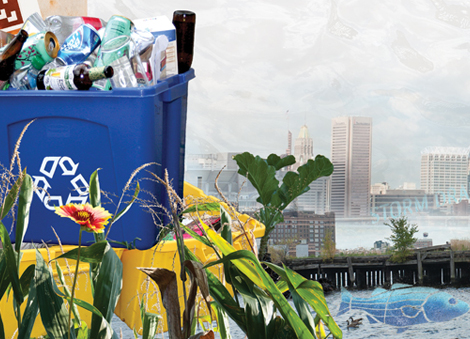
UMBC is making big steps toward making the university’s campus more sustainable. But as a state research university that’s growing every year, the faculty of UMBC and researchers affiliated with the university are also investigating how to make our cities and our planet greener. They are creating new products that will cut down on pollution and waste. And they are creating works of art that help us feel more tangibly the effects of climate change.
One of the most important centers for such research on campus is UMBC’s Center for Urban Environmental Research and Education (CUERE). The projects pursued at CUERE include research on public health, energy management, ecological sociology, meteorology, and soil study. The center also is host to the Baltimore Ecosystem Study, a project funded by the National Science Foundation (NSF) as part of the foundation’s Long Term Ecological Research Program.
Stuart S. Schwartz, a senior researcher at CUERE, has worked on multiple fronts to address the problem of storm runoff (which is one of the main conduits of pollution to the Cheaspeake Bay) – including spearheading use of “pervious concrete” which allows water to infiltrate the surface instead of running off. The concrete has been used on UMBC’s campus, and the center has successfully prodded other state agencies in Maryland to give it a try – including Park-n-Ride lots for the Maryland Transit Administration and State Highway Administration and a pervious concrete lot for the Maryland Science Center.
Another prominent UMBC researcher who’s tackled climate issues is Ray Hoff, a recently-retired professor of physics and senior science advisor to the Joint Center for Earth Systems Technology (JCET). In collaboration with Jill Engel-Cox, ’04, Ph.D., marine estuarine environmental science, Hoff created the “Smog Blog” – a website that merges real-time satellite imagery and air quality data with analysis of air pollution across the United States for people interested in air quality. The “Smog Blog” has logged more than 50 million hits during its first eight years.
In the following pages, we’d like to introduce you to other UMBC faculty who are pursuing research or creative projects – some of them in unusual places – that give us deeper insight into the causes (and possible solutions) of our climate crisis.
– Richard Byrne’ 86 and Joel N. Shurkin
Tags: Fall 2013

